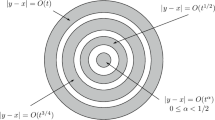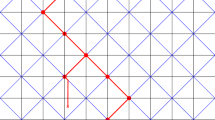Abstract
We consider a model of stochastically interacting particles on an infinite strip of ℤ2; in this model, known as a branching exclusion process, particles jump to each empty neighboring site with rate λ/4 and also can create a new particle with rate 1/4 at each one of these sites. The initial configuration is assumed to have a rightmost particle and we study the process as seen from the rightmost vertical line occupied. We prove that this process has exactly one invariant measure with the property thatH, the number of empty sites to the left of the rightmost particle, has an exponential moment. This refines a result presented by Bramson {eaet al.}, who proved that ford=1,H is finite with probability 1.
Similar content being viewed by others
References
M. Bramson, Front propagation in certain one-dimensional exclusion models,J. Stat. Phys. 51(5/6):863–869 (1988).
M. Bramson, Convergence of solutions of the Kolmogorov equation to traveling waves.Mem. Am. Math. Soc. 25: (1986).
M. Bramson, P. Calderoni, A. De Masi, P. Ferrari, J. Lebowitz, and R. H. Schonmann. Microscopic selection principle for a diffusion-reaction equation,J. Stat. Phys. 45:56–70 (1986).
M. Bramson and D. Griffeath, On the Williams-Bjerknes tumour growth model 1,Ann. Prob. 9(2):173–185 (1981).
J. T. Cox and R. Durrett, Hybrid zones and voter model interfaces,Bernoulli 1:343–370 (1995).
C. Cammarotta and P. A. Ferrari, An invariance principle for the edge of the branching exclusion process.Stoch. Proc. Appl. 38:1–11 (1991).
R. Durrett,Lecture Notes on Particle Systems and Percolation (Wadsworth and Brooks/Cole, Pacific Grove, California, 1988).
R. Durrett and D. Griffeath, Contact process in several dimensions,Z. Wahrsch. Verw. Gebiet 59:535–552 (1982).
R. S. Ellis,Large Deviations and Statistical Mechanics, (Springer, New York, 1985).
W. Feller,An Introduction to Probability Theory and its Applications (Wiley, New York, 1968).
P. Ferrari, Growth processes on a strip. Relatório Técnico/USP RT-MAE-9207 (1992).
A. Kerstein, Computational study of propagating fronts in a lattice-gas model.J. Stat. Phys. 45(5/6):921–931 (1986).
A. Kerstein, A two-particle representation of front prpagation in diffusion-reaction systems,J. Stat. Phys. 53(3/4):703–712 (1988).
T. M. Liggett,Interacting Particle Systems (Springer-Verlag, New York, 1985).
F. Machado, Asymptotic results for the branching exclusion process. Ph.D. thesis. Instituto de Matemática e Estatística, Universidade de São Paulo (1994).
F. Machado, Asymptotic shape of the branching exclusion process, in preparation (1996).
A. De Masi, P. Ferrari, and J. Lebowitz, Reaction-diffusion equations for interacting particle systems,J. Stat. Phys. 44(3/4):589–644 (1986).
Author information
Authors and Affiliations
Rights and permissions
About this article
Cite this article
Machado, F.P. Branching exclusion process on a strip. J Stat Phys 86, 765–777 (1997). https://doi.org/10.1007/BF02199119
Received:
Accepted:
Issue Date:
DOI: https://doi.org/10.1007/BF02199119




